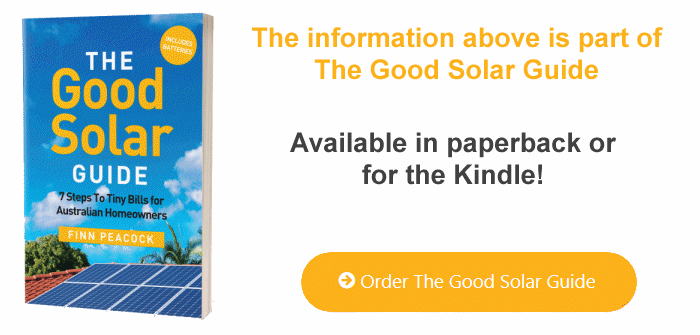Collecting your meter data
← Reading Your Meter | The Good Solar Guide Contents | Heating Your Water →
Now you know how to get the numbers, and whether you have a mechanical or an electronic meter, I’m going to show you how to quickly, and without cost, measure your daytime electricity usage for a typical work day and a typical non-work day in your home. This is because being at home makes a big difference to how much energy you use (who’d have thought!).
We’ll also measure typical night-time use, but we won’t differentiate between work nights and non-work nights, because in my experience they don’t differ much. After all, you’re asleep for most of the time.
We’ll do this by reading your electricity meter four times in 48 hours and then doing some sums with the results.
If you have a smart meter and an online portal, you don’t need to do the manual readings. You can log in and get these numbers instead. For the rest of us, read on.
How to measure your two daytime usages and typical night-time usage
I’ll walk you through the process for Sunday (non-work daytime) and Monday (work daytime). Of course, if you aren’t a typical worker bee, feel free to use any two days of the week that capture your work and non-work lifestyle the best.
Online resource: The most difficult thing about this exercise is remembering to take the readings. To make it easier to remember, I’ve created a calendar file that will prompt you to take the four readings with four alarms. Simply go to this link on your smartphone: solarquotes.com.au/alarms
We’re going to read your meter at the following times:
- Sunday 9am
- Sunday 7pm
- Monday 9am
- Monday 7pm
Then we’ll put the readings in a table like this:
| 9am | 7pm | |
| Sunday | ||
| Monday |
There’s a blank, printable copy of the data-collection table on your worksheet: solarquotes.com.au/worksheet.
Example
Here’s the data-collection table printed out and completed for my house:
| 9am | 7pm | |
| Sunday | 16030.4 | 16038.6 |
| Monday | 16042.2 | 16051.3 |
I then put the four numbers into this online calculator: solarquotes.com.au/calc.
It pops out my work and non-work daytime electricity usages, and one nighttime usage. Figure 2.8 shows how the simple calculation works. The figures are typically all between 3 and 30 kWh. If yours are not, double-check your readings.
My daytime usage – Sunday: 8.2 kWh
My daytime usage – Monday: 9.1 kWh
My night-time usage – 3.6 kWh
It also spits out my daytime usage averaged over the whole week, based on a week containing 5 work days and 2 non-work days:
8.46 kWh.

Figure 2.8 Usage readings
The weekly average daytime usage and the night-time usage are the two magic numbers that we need to:
- Get a preliminary size for your solar power system, and
- Estimate the financial returns of the system.
Now’s the time to make plans to record your meter four times this weekend (or pull the numbers from your smart meter portal).
Once you have the readings, crunch the numbers online.
Record the results on your worksheet:
Weekly average daytime usage:_____kWh
Night-time usage:_____kWh
We’ll use these numbers to work out your personal solar payback in Step 4. First, we need to have a good look at how you heat your hot water. You have a choice to make that will affect how many panels you need and how fast they’ll pay you back.
Summary
To predict potential savings from solar accurately you need to estimate your solar self-consumption. You have two options:
- If you want to move through the seven steps with no delay, simply use a worst- and best-case estimate for your self-consumption ratio. I suggest a worst case of 10% and a best case of 70%.
- If you can commit to understanding how your house is metered, then take four meter readings over next Sunday and Monday. You will be rewarded with a much better estimate of your self-consumption ratio, which will lead to a more accurate solar savings estimate in Step 4.
← Reading Your Meter | The Good Solar Guide Contents | Heating Your Water →
Questions or feedback about the content on this page? Contact me.
